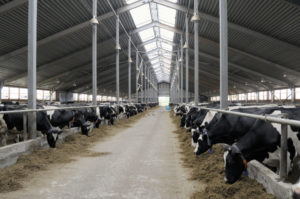Housing
Are your youngstock sheds adapted for winter weather? Calf sheds need to be well ventilated, clean, dry and free from draughts at calf height. Moisture builds up in passageways and pens which can have a negative impact on calf health, increasing the risk of scour and pneumonia. Think about fixing the gutters and any leaking skylights you have been meaning to do all summer. Do your sheds have adequate ventilation? A lack of ventilation will create stale air, increasing the risk of pneumonia pathogens surviving in the environment and spreading between calves. One quick, easy way to test ventilation would be using a smoke bomb which will highlight problem areas in your calf housing.
Temperatures dropping to between 10-15°C will decrease the growth and performance of newborn calves. Calves may huddle, shiver and try to move away from draughts. Providing plenty of fresh, deep bedding daily, nesting areas and blocking draughts at calf height with stock board or bales will help to keep calves warm. Other things to consider are the use of calf jackets on newborn calves. During colder spells also consider increasing the quantity of milk replacer calves are receiving. This will help to maintain good growth rates.
Pneumonia Prevention
Calf pneumonia or bovine respiratory disease (BRD) is one of the costliest diseases in the cattle industry. The immediate measurable costs have been estimated at £43 per case, but it’s the less visible costs that have the really big impact; heifers with a history of BRD before weaning are less likely to be inseminated or achieve first calving than heifers without BRD. Once they join the adult herd, their yield may be reduced even into their second lactation. Any heifers that need more than one treatment for BRD are much less likely to reach their second lactation. When you take into account the long-term impact of BRD it’s easy to see how the cost can really stack up.
Prevention is always better than cure and developing a plan for your farm aimed at optimising calf health will be hugely beneficial. Calf health plans should include gold standard colostrum management, good housing and husbandry along with the use of correct vaccinations, to help reduce antibiotic usage on farm.
Adults
IBR Control
Infectious bovine rhinotracheitis (IBR) is a highly contagious cause of adult pneumonia. Clinical signs, including high temperatures with nasal and ocular discharge, loss of appetite and reduced milk yield, usually occur 2-3 weeks after a stressor or change in management e.g., winter housing. Consider IBR herd vaccination pre-housing to help reduce the risk of an outbreak.
Fluke treatment
Fluke can present as both subclinical and clinical infections in dairy cattle. Some farms will experience reduced milk yield and poor fertility whereas visible clinical signs include excessive weight loss and chronic scour. Dairy cows pick fluke up off pasture during the grazing season and therefore if diagnosed at housing we recommend using a suitable flukicide.
Preventing Lameness
Digital dermatitis is still one of the major causes of lameness in dairy cows, affecting both cow welfare and productivity. During winter months is generally when we see a spike in cases due to housing and increased slurry around the yards. Prompt treatment of cases is paramount to help reduce the spread through the herd. Monitoring feet through the parlour will help achieve this. Make sure you have a strategic foot bathing protocol in place, along with good slurry management on yards and cubicle housing.
For further advice on your winter housing, please speak to your local NWF Sales Specialist.
Thank you to Sandstone Vets for their contribution.

